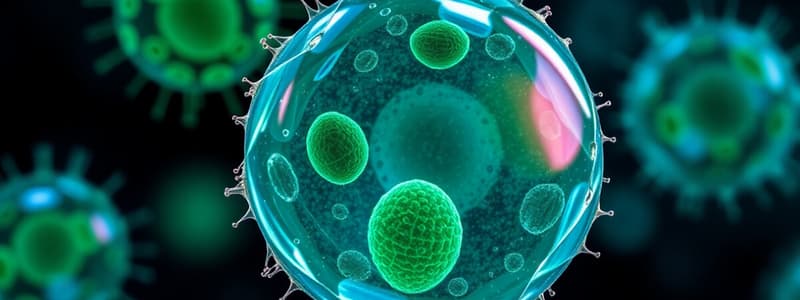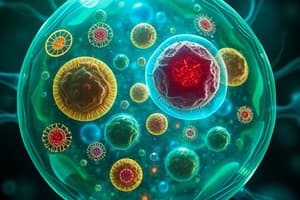Podcast
Questions and Answers
What is the main function of the membrane surrounding every cell?
What is the main function of the membrane surrounding every cell?
- To keep the cell's contents separate from the external environment. (correct)
- To produce energy for the cell.
- To provide structural support to the cell
- To facilitate communication between cells.
Prokaryotic and eukaryotic cells both contain membrane-bound organelles.
Prokaryotic and eukaryotic cells both contain membrane-bound organelles.
False (B)
What type of instrument is typically required to view some cell organelles?
What type of instrument is typically required to view some cell organelles?
electron microscope
To keep their activities separate, cells use membrane-bound little structures known as ______ .
To keep their activities separate, cells use membrane-bound little structures known as ______ .
Match the following organelles with their broader function within the cell:
Match the following organelles with their broader function within the cell:
Which cells require a high amount of chemical activities to maintain their structure and function?
Which cells require a high amount of chemical activities to maintain their structure and function?
Organelles are present in both eukaryotic and prokaryotic cells.
Organelles are present in both eukaryotic and prokaryotic cells.
What is the primary function of cell organelles?
What is the primary function of cell organelles?
Examples of organelles include endoplasmic reticulum, Golgi apparatus, lysosomes, mitochondria, and ______.
Examples of organelles include endoplasmic reticulum, Golgi apparatus, lysosomes, mitochondria, and ______.
Match each cell type with its predominant structural characteristic:
Match each cell type with its predominant structural characteristic:
Which of the following is a key characteristic that distinguishes eukaryotic cells from prokaryotic cells?
Which of the following is a key characteristic that distinguishes eukaryotic cells from prokaryotic cells?
All cell organelles are visible using a standard light microscope.
All cell organelles are visible using a standard light microscope.
Name three examples of cell organelles.
Name three examples of cell organelles.
The ______ surrounds every cell, keeping its contents separate from the external environment.
The ______ surrounds every cell, keeping its contents separate from the external environment.
Match the following terms to their descriptions:
Match the following terms to their descriptions:
What is the primary reason large and complex cells need a lot of chemical activities?
What is the primary reason large and complex cells need a lot of chemical activities?
All cells must contain membrane-bound organelles to survive
All cells must contain membrane-bound organelles to survive
What is the name of the organelle that has been examined in a previous section of this text?
What is the name of the organelle that has been examined in a previous section of this text?
Large and complex cells, like those from multicellular organisms, require a lot of ______ activities to maintain structures and function.
Large and complex cells, like those from multicellular organisms, require a lot of ______ activities to maintain structures and function.
Match the following cell organelles with how each are visualized:
Match the following cell organelles with how each are visualized:
Flashcards
Cell Organelles
Cell Organelles
Membrane-bound structures within cells that carry out specific functions.
Organelles Feature which type of cell?
Organelles Feature which type of cell?
The cell part found in eukaryotic cells which distinguishes them from prokaryotic cells.
Endoplasmic Reticulum (ER)
Endoplasmic Reticulum (ER)
A network of membranes involved in protein and lipid synthesis.
Golgi Apparatus
Golgi Apparatus
Signup and view all the flashcards
Lysosomes
Lysosomes
Signup and view all the flashcards
Mitochondria
Mitochondria
Signup and view all the flashcards
Plastids
Plastids
Signup and view all the flashcards
Study Notes
- Cells have a membrane to keep their contents separate from the outside environment
- Big and complex cells, even from multicellular organism need many chemical activities to keep their complicated structure and working order
- Cells use membrane-bound structures (called organelles) inside themselves to keep the different chemical activities separate.
- Eukaryotic cells use organelles, while prokaryotic cells do not
- Some organelles can only be seen using an electron microscope.
- Examples of cell organelles:
- Endoplasmic reticulum
- Golgi apparatus
- Lysosomes
- Mitochondria
- Plastids
- Organelles carry out crucial functions in cells.
Studying That Suits You
Use AI to generate personalized quizzes and flashcards to suit your learning preferences.




